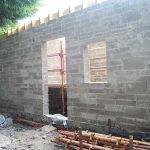The septic tank conducts primary treatment only, the percolation area is vital as it provides most of the treatment. It consists of a series of perforated drains running from the tank with gravel bed, gravel protection layer and soil, acting as a further filter for the finer suspended solids. Issues have arisen from these clogging up with suspended solids after just 10 years, a reason why secondary treatment has become the preferred option.
A septic tank requires a small amount of space, a hole approximately 2.5m wide x 3m deep. In ROI most tanks are made from concrete but in NI glass reinforced plastic (GRP) is the most popular choice, in which case it must be set in concrete to secure it in the ground in case there is a rise in the water table. The tank will then be covered by a manhole which is the only visible sign you have one.
Septic tanks require desludging – removal of the solids collected at the bottom, normally annually although with some systems it can be as much as every three years, depending on the type of tank and the number of people it serves.
The EPA recommends that as a guide, it should be emptied when the depth of sludge in the second chamber is greater than 400mm. With this in mind, site your tank so that you are not an unwilling spectator for this event when the tanker parks at the front of the house. The best location is at the rear or to one side, always remembering to ensure clear access and firm ground to take the weight of the lorry.
There are also restrictions on where you site your tank and percolation area in relation to watercourses and other dwellings (see EPA guidelines). In NI contact the Water Management Unit.
Packaged treatment systems (secondary treatment)
Many areas don’t have ideal soil conditions. In Connemara, for example there is often a shallow topsoil and subsoil layer, and oftentimes you’ll find boggy land, both of which are also common in other parts of the country. In those instances you could get a secondary treatment system built on site such as a constructed wetland (see below) but what is more common is to buy a packaged system.
Most packaged systems will require regular maintenance as they often rely on complex mechanical parts. The system designers and installers will advise you on this, and if they don’t, make sure to ask! That’s an important point to consider as you will need to follow the maintenance regime otherwise the system could underperform in its lifetime. The costs for package treatment systems are also higher, and can start at around €6,000/£5,000 including the polishing filter for which you will probably have to import soil or sand.
Packaged treatment plants are therefore an option if your soil is not porous enough for a standard septic tank. If you’re dealing with impervious soil and/or subsoil and/or poorly permeable bedrock that will not benefit from site improvement works then you may need to discharge to a nearby watercourse such as a river, stream or ditch (this is only really an option in NI).







